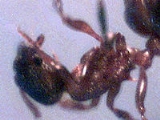
Pavement ant
Encyclopedia
The pavement ant
, Tetramorium caespitum, is a common household pest. Its name comes from the fact that colonies usually make their homes in pavement. It is distinguished by one spine on the back, two nodes on the petiole, and grooves on the head and thorax . The species is native to Europe, but was introduced to North America in the 18th century.
During early spring, colonies attempt to conquer new areas and often attack nearby enemy colonies. These result in huge sidewalk battles, sometimes leaving thousands of ants dead. Because of their aggressive nature, they often invade and colonize seemingly impenetrable areas.
In summer time the ants dig out the sand in between the pavements to vent the nests.

Ant
Ants are social insects of the family Formicidae and, along with the related wasps and bees, belong to the order Hymenoptera. Ants evolved from wasp-like ancestors in the mid-Cretaceous period between 110 and 130 million years ago and diversified after the rise of flowering plants. More than...
, Tetramorium caespitum, is a common household pest. Its name comes from the fact that colonies usually make their homes in pavement. It is distinguished by one spine on the back, two nodes on the petiole, and grooves on the head and thorax . The species is native to Europe, but was introduced to North America in the 18th century.
During early spring, colonies attempt to conquer new areas and often attack nearby enemy colonies. These result in huge sidewalk battles, sometimes leaving thousands of ants dead. Because of their aggressive nature, they often invade and colonize seemingly impenetrable areas.
In summer time the ants dig out the sand in between the pavements to vent the nests.


